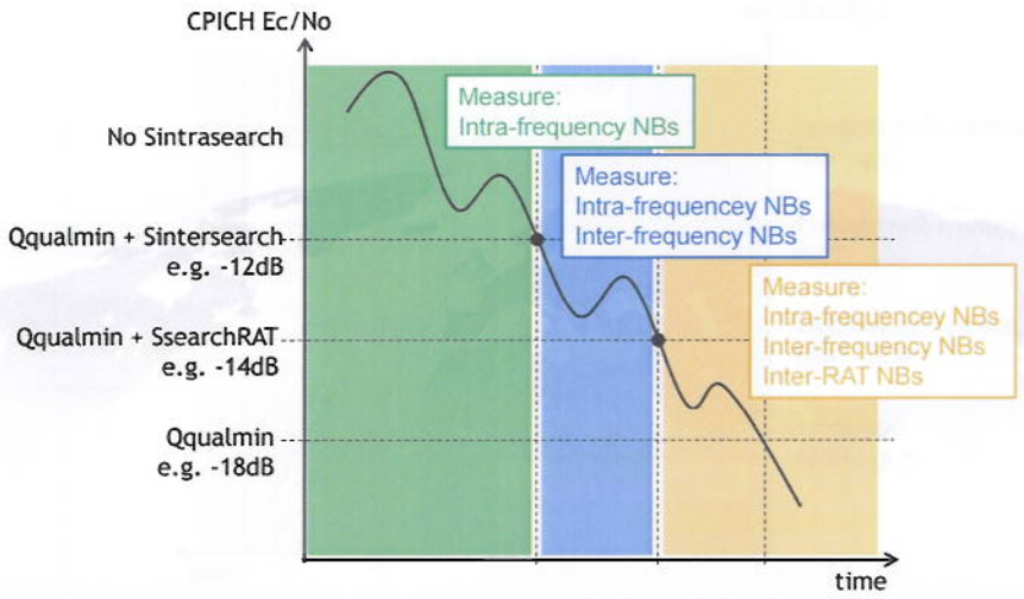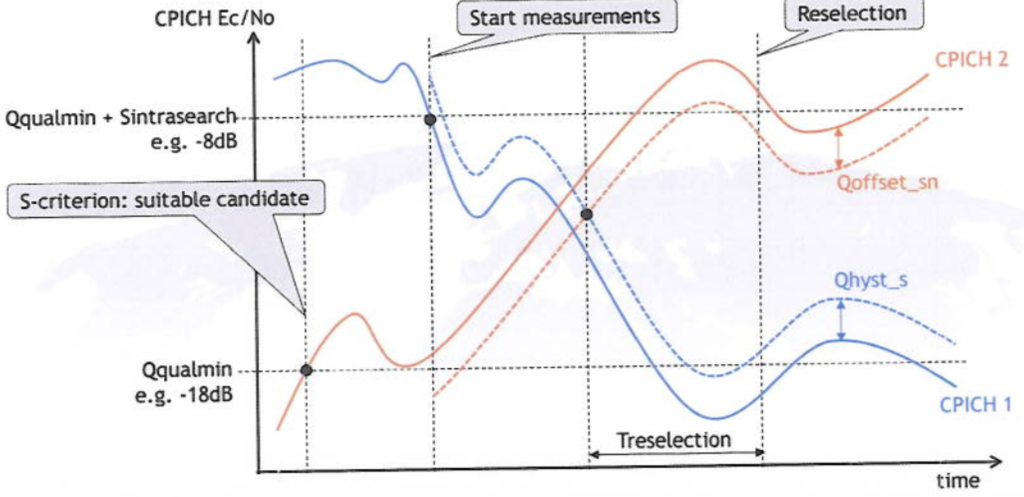The following procedures regarding 3G cell reselection need to be followed:
- Measurement rules.
- S-criterion.
- R-criterion.
- Trigger.
The above points gives an overview of the procedures that need to be followed regarding 3G cell reselection. First of all the measurement rules will be analysed. These will tell the UE what to measure, and when to measure. Next the S-criterion will rule what cells are suitable cell reselection candidates.
After this a ranking will be made between all cell reselection candidates using the R-criterion. At the end the triggering condition will determine how quickly the actual reselection can be done if all the previous conditions are fulfilled.
1. Measurement Rules of 3G Cell Reselection.

The figure above shows all parameters regarding the measurement rules procedure for 3G cell reselection. We assume the UE is initially camping on a 3G cell with very good CPICH Ec/No. The first parameter to look at is Sintrasearch. The threshold Qqualmin + Sintrasearch will determine if intra-frequency neighbours need to be measured or not. If CPICH Ec/No of the serving cell is above this threshold, then there is no need to measure and the UE is happy with the serving cell.
However, if the CPICH Ec/No drops below this threshold the UE will start to measure the intra-frequency neighbours, Lets assume now that the Ec/No is even dropping further below a second threshold Qqualmin + Sintrasearch. If this happens the UE will not only measure the intra-frequency neighbours, but also the inter-frequency neighbours.
Finally, if the CPICH Ec/No drops below the threshold Qqualmin + SsearchRAT, then in addition also the inter-RAT neighbours need to be measured. As a conclusion, the worse the quality of the serving cell, the more neighbour types need to be measured.

In the figure above no value for Sintrasearch is given. Under this condition the intra-frequency neighbours need to be measured all the time, whatever the Ec/No of the serving cell. All other parameters and thresholds in the figure remain unchanged.
2. Hysteresis of 3G Cell Reselection.
- Cell reselection ping pong: called party not reachable.
- Sufficient hysteresis needed between 2G → 3G and 3G → 2G cell reselection to avoid ping pong.
- At least 3db hysteresis recommended e.g. FDD_Qmin =-12db, Qqualmin + SsearchRAT = -158db.

The figure above shows what happens if the hysteresis between 2G to 3G and 3G to 2G cell reselection is too small. Lets assume FDD_Qmin is equal to -13db, a quite common value. This means that the reselection to a 3G cell can only be done if the CPICH Ec/No of this cell is above -13dB.
Lets assume on the other hand that Qqualmin + SsearchRAT is equal to -14dB. This means that if the CPICH Ec/No drops below -14dB, the UE starts to measure 2G neighbours and performs the reselection to one of them if ranked best. In the figure these two thresholds are used, and the CPICH Ec/No is fluctuating around these thresholds, resulting in ping pong between 2G to 3G and 3G to 2G cell reselection.
The resulting hysteresis of 1dB is not sufficient to avoid this ping pong behaviour. It is recommended to use a hysteresis of at least 3dB to avoid this kind of behaviour. If the called party is in cell reselection, then it is not reachable and even redirection to voice mail is not done. It is better to avoid this problematic situation and to introduce sufficient hysteresis from the start.
3. R-criterion of 3G Cell Reselection.
Ranking criterion.
- R-value calculated for serving cell and neighbours.
- R_s Qmeas_s + Qhyst_s
- R_n= Qmeas_n – Qoffset_sn
- Qoffset_sn: defined per handover relation.
- Reselection to best ranked candidate.
- If 2G candidates present: ranking based on level (3G RSCP/2G RSSI).
- If 2G cell ranked first: perform reselection to this cell.
- If 3G cell ranked first.
- Ignore alt 2G candidates.
- Perform new ranking based on 3G Ec/No.
- Perform reselection to best ranked 3G cell.
- If 2G candidates present: ranking based on level (3G RSCP/2G RSSI).
- If only 3G candidates: ranking based on quality (Ec/No).
- Perform reselection to best ranked 3G cell.
The next procedure under study is the R-criterion which stands for Ranking criterion. When reselection is considered from a 3G serving cell to both 2G or 3G neighbours, the R-value should be calculated for both server and neighbours.
Typically a positive hysteresis is added to favour the serving cell. In addition an offset, defined per handover relation, is added to all neighbours. The most suitable candidate can now be selected based on the calculated R-value. If both 2G and JG candidates are present, ranking should be done based on RSCP/RSSI level.
If a2G cell is ranked best, reselection will be performed to this cell. If a 3G cell is ranked best, a new ranking will be done between the 3G cells based on CPICH Ec/No, and the 2G candidates will be ignored. If only 3G candidates are present ranking will be done based on CPICH Ec/No only, and reselection is performed to the highest ranked cell.
4. Trigger of 3G Cell Reselection.
A cell reselection to the best candidate can be performed under the following conditions:
- UE must be camping on the serving cell for at least 1s.
- The reselection candidate must be ranked better than the serving cell for the duration of the timer Treselection .
Before the actual reselection can be done, two additional conditions need to be fulfilled. The UE must be camping on the serving cell for at least one second. In addition, the reselection candidate must be ranked better than the serving cell for the duration of the timer Treselection.
5. 3G Cell Reselection Graphical Procedure.

The figure above gives an overview of the complete reselection process between two 3G cells. It is assumed that the quality of the 3G serving cell is going down, and at the same time the quality of the 3G neighbour cell is going up. Initially the quality of the serving cell is above the threshold Qqualmin + Sintrasearch, and there is no need to measure.
As soon as the quality drops below this threshold the UE starts to measure the intra-frequency neighbours. Since the quality of the 3G neighbour exceeds Qqualmin, this cell is suitable for reselection.
To be exact also the RSCP part of the S-criterion needs to be fulfilled, but normally this should not be a problem when fulfilling the Ec/No requirement. The R-criterion is applied now, and serving cell (with hysteresis) is compared against the best neighbour (with offset). As soon as the neighbour cell is better than the serving cell for an amount of time Treselection, the actual reselection is performed.